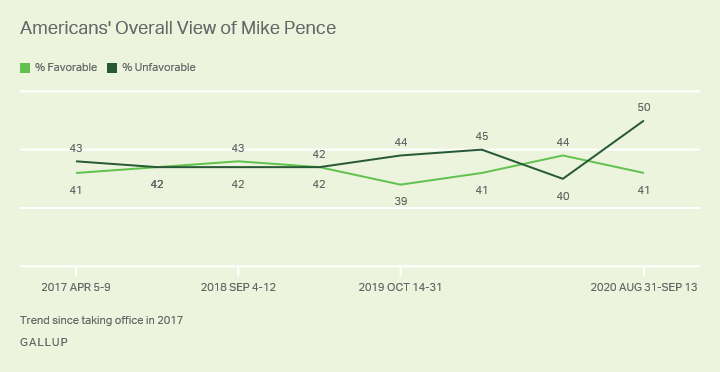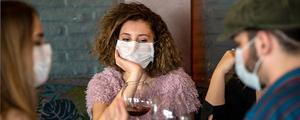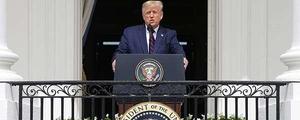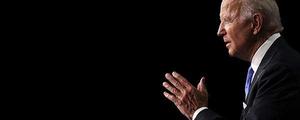Story Highlights
- Biden viewed favorably by 46% of U.S. adults, Trump at 41%
- VP nominees have similar favorable scores; Pence has higher negatives
- Melania Trump's rating unchanged following GOP convention
WASHINGTON, D.C. -- Heading into presidential debate season, former Vice President Joe Biden edges out President Donald Trump in favorability ratings from the American people, 46% to 41%, while the candidates' running mates are roughly tied in favorability. Sen. Kamala Harris, running for vice president on the Democratic ticket, is viewed favorably by 42% of Americans, similar to the 41% rating for Republican Vice President Mike Pence.
| Favorable | Unfavorable | No opinion | |||||||||||||||||||||||||||||||||||||||||||||||||||||||||||||||||||||||||||||||||||||||||||||||||
|---|---|---|---|---|---|---|---|---|---|---|---|---|---|---|---|---|---|---|---|---|---|---|---|---|---|---|---|---|---|---|---|---|---|---|---|---|---|---|---|---|---|---|---|---|---|---|---|---|---|---|---|---|---|---|---|---|---|---|---|---|---|---|---|---|---|---|---|---|---|---|---|---|---|---|---|---|---|---|---|---|---|---|---|---|---|---|---|---|---|---|---|---|---|---|---|---|---|---|---|
| % | % | % | |||||||||||||||||||||||||||||||||||||||||||||||||||||||||||||||||||||||||||||||||||||||||||||||||
| Donald Trump | 41 | 57 | 2 | ||||||||||||||||||||||||||||||||||||||||||||||||||||||||||||||||||||||||||||||||||||||||||||||||
| Joe Biden | 46 | 50 | 4 | ||||||||||||||||||||||||||||||||||||||||||||||||||||||||||||||||||||||||||||||||||||||||||||||||
| Mike Pence | 41 | 50 | 9 | ||||||||||||||||||||||||||||||||||||||||||||||||||||||||||||||||||||||||||||||||||||||||||||||||
| Kamala Harris | 42 | 43 | 15 | ||||||||||||||||||||||||||||||||||||||||||||||||||||||||||||||||||||||||||||||||||||||||||||||||
| Gallup, Aug. 31-Sep. 13, 2020 | |||||||||||||||||||||||||||||||||||||||||||||||||||||||||||||||||||||||||||||||||||||||||||||||||||
The latest results are based on Gallup's annual Governance poll, conducted by telephone Aug. 31-Sept. 13.
Trump and Biden's unfavorable ratings are about the inverse of their favorable ratings. Both receive higher unfavorable than favorable ratings, although the balance of opinion is more negative for Trump. Trump now earns a -16 net-favorable rating (percentage favorable minus percentage unfavorable) while Biden has a -4 net-favorable rating.
Trump is better viewed today than he was at the same stage of the campaign in 2016 when 33% viewed him favorably and 62% unfavorably. Trump's ratings that year hadn't improved by Election Day when 34% viewed him favorably and 62% unfavorably. His opponent, Hillary Clinton, also suffered from sub-40% favorability in a late August/early September poll. And while her favorable rating rose to 43% by Election Day, it was still among the lowest for presidential candidates since Gallup began measuring favorability with this question wording in 1992.
The only other candidate to receive a favorable score in the low 40s in Gallup's final pre-election reading was George H. W. Bush in 1992. Mitt Romney had a 46% in 2012, while all other candidates earned 50% or better favorability.
| Late August/Early September | Final pre-election | |||||||||||||||||||||||||||||||||||||||||||||||||||||||||||||||||||||||||||||||||||||||||||||||||||
|---|---|---|---|---|---|---|---|---|---|---|---|---|---|---|---|---|---|---|---|---|---|---|---|---|---|---|---|---|---|---|---|---|---|---|---|---|---|---|---|---|---|---|---|---|---|---|---|---|---|---|---|---|---|---|---|---|---|---|---|---|---|---|---|---|---|---|---|---|---|---|---|---|---|---|---|---|---|---|---|---|---|---|---|---|---|---|---|---|---|---|---|---|---|---|---|---|---|---|---|---|
| % | % | |||||||||||||||||||||||||||||||||||||||||||||||||||||||||||||||||||||||||||||||||||||||||||||||||||
| 2020 | ||||||||||||||||||||||||||||||||||||||||||||||||||||||||||||||||||||||||||||||||||||||||||||||||||||
| Donald Trump | 41 | -- | ||||||||||||||||||||||||||||||||||||||||||||||||||||||||||||||||||||||||||||||||||||||||||||||||||
| Joe Biden | 46 | -- | ||||||||||||||||||||||||||||||||||||||||||||||||||||||||||||||||||||||||||||||||||||||||||||||||||
| 2016 | ||||||||||||||||||||||||||||||||||||||||||||||||||||||||||||||||||||||||||||||||||||||||||||||||||||
| Donald Trump | 33 | 34 | ||||||||||||||||||||||||||||||||||||||||||||||||||||||||||||||||||||||||||||||||||||||||||||||||||
| Hillary Clinton | 38 | 43 | ||||||||||||||||||||||||||||||||||||||||||||||||||||||||||||||||||||||||||||||||||||||||||||||||||
| 2012 | ||||||||||||||||||||||||||||||||||||||||||||||||||||||||||||||||||||||||||||||||||||||||||||||||||||
| Barack Obama | 53 | 55 | ||||||||||||||||||||||||||||||||||||||||||||||||||||||||||||||||||||||||||||||||||||||||||||||||||
| Mitt Romney | 48 | 46 | ||||||||||||||||||||||||||||||||||||||||||||||||||||||||||||||||||||||||||||||||||||||||||||||||||
| 2008 | ||||||||||||||||||||||||||||||||||||||||||||||||||||||||||||||||||||||||||||||||||||||||||||||||||||
| Barack Obama | 63 | 62 | ||||||||||||||||||||||||||||||||||||||||||||||||||||||||||||||||||||||||||||||||||||||||||||||||||
| John McCain | 59 | 50 | ||||||||||||||||||||||||||||||||||||||||||||||||||||||||||||||||||||||||||||||||||||||||||||||||||
| 2004 | ||||||||||||||||||||||||||||||||||||||||||||||||||||||||||||||||||||||||||||||||||||||||||||||||||||
| George W. Bush | 54 | 51 | ||||||||||||||||||||||||||||||||||||||||||||||||||||||||||||||||||||||||||||||||||||||||||||||||||
| John Kerry | 52 | 52 | ||||||||||||||||||||||||||||||||||||||||||||||||||||||||||||||||||||||||||||||||||||||||||||||||||
| 2000 | ||||||||||||||||||||||||||||||||||||||||||||||||||||||||||||||||||||||||||||||||||||||||||||||||||||
| George W. Bush | 60 | 55 | ||||||||||||||||||||||||||||||||||||||||||||||||||||||||||||||||||||||||||||||||||||||||||||||||||
| Al Gore | 64 | 56 | ||||||||||||||||||||||||||||||||||||||||||||||||||||||||||||||||||||||||||||||||||||||||||||||||||
| 1996 | ||||||||||||||||||||||||||||||||||||||||||||||||||||||||||||||||||||||||||||||||||||||||||||||||||||
| Bill Clinton | 61 | 56 | ||||||||||||||||||||||||||||||||||||||||||||||||||||||||||||||||||||||||||||||||||||||||||||||||||
| Bob Dole | 53 | 50 | ||||||||||||||||||||||||||||||||||||||||||||||||||||||||||||||||||||||||||||||||||||||||||||||||||
| 1992 | ||||||||||||||||||||||||||||||||||||||||||||||||||||||||||||||||||||||||||||||||||||||||||||||||||||
| George H. W. Bush | 45 | 43 | ||||||||||||||||||||||||||||||||||||||||||||||||||||||||||||||||||||||||||||||||||||||||||||||||||
| Bill Clinton | 57 | 51 | ||||||||||||||||||||||||||||||||||||||||||||||||||||||||||||||||||||||||||||||||||||||||||||||||||
| Gallup | ||||||||||||||||||||||||||||||||||||||||||||||||||||||||||||||||||||||||||||||||||||||||||||||||||||
Pence Lags Harris in Net Favorability
Despite having similar favorable ratings, the vice-presidential candidates' images diverge when factoring in their unfavorable ratings, as more view Pence (50%) than Harris (43%) unfavorably. As a result, Pence's image tilts negative, while Harris is viewed about equally positively and negatively.
Pence's current unfavorable rating is up from 40% in April and is the highest to date in his time as vice president.

Line graph. Trend in favorable ratings of Mike Pence. He was viewed about as positively in 2017 and 2018, but his image has since been more negative than positive, except for early 2020. His latest reading from early September is 41% favorable, 50% unfavorable.
The main change in Harris' image since being tapped as Biden's running mate on August 12 is that she has become more widely known. Whereas 40% had either not heard of the California senator or had no opinion of her as recently as July, this has dropped to 15%. Meanwhile, both her favorable and unfavorable ratings have increased, which is typical when public figures gain national visibility.

Line graph. Trend in favorable ratings of Kamala Harris since February 2019. Her favorable and unfavorable ratings have continuously been closely matched, but more recently saw both ratings rise as the percentage not familiar with her dropped sharply after she was chosen to be the running mate for Joe Biden. She is now viewed favorably by 43% and unfavorably by 42%.
Harris Choice Receives Subdued Praise
Gallup has measured public reaction to vice-presidential selections every election year since 2000, asking registered voters to describe the choice as "excellent," "pretty good," "only fair," or "poor." With 47% of registered voters nationally describing Harris as an excellent or pretty good choice, she is viewed about as well as both parties' vice-presidential choices in the week following their respective conventions in 2016: Tim Kaine, at 45% and Pence at 43%.
According to Gallup trends, new presidential running mates received more praise in all earlier elections. This ranged from 51% calling Rep. Paul Ryan an excellent or pretty good choice when he was chosen by Mitt Romney for the Republican ticket in 2012, to 64% rating John Edwards this well after John Kerry put him on the Democratic ticket in 2004.
Biden was one of the more highly rated vice-presidential choices when he was first tapped by Barack Obama in 2008, with 63% seeing him as an excellent or pretty good choice.
| Excellent/Pretty good | Only fair/Poor | ||||||||||||||||||||||||||||||||||||||||||||||||||||||||||||||||||||||||||||||||||||||||||||||||||
|---|---|---|---|---|---|---|---|---|---|---|---|---|---|---|---|---|---|---|---|---|---|---|---|---|---|---|---|---|---|---|---|---|---|---|---|---|---|---|---|---|---|---|---|---|---|---|---|---|---|---|---|---|---|---|---|---|---|---|---|---|---|---|---|---|---|---|---|---|---|---|---|---|---|---|---|---|---|---|---|---|---|---|---|---|---|---|---|---|---|---|---|---|---|---|---|---|---|---|---|
| % | % | ||||||||||||||||||||||||||||||||||||||||||||||||||||||||||||||||||||||||||||||||||||||||||||||||||
| Biden's choice of Kamala Harris (2020) | 47 | 52 | |||||||||||||||||||||||||||||||||||||||||||||||||||||||||||||||||||||||||||||||||||||||||||||||||
| Hillary Clinton's choice of Tim Kaine (2016) | 45 | 48 | |||||||||||||||||||||||||||||||||||||||||||||||||||||||||||||||||||||||||||||||||||||||||||||||||
| Donald Trump's choice of Mike Pence (2016) | 43 | 51 | |||||||||||||||||||||||||||||||||||||||||||||||||||||||||||||||||||||||||||||||||||||||||||||||||
| Mitt Romney's choice of Paul Ryan (2012) | 51 | 39 | |||||||||||||||||||||||||||||||||||||||||||||||||||||||||||||||||||||||||||||||||||||||||||||||||
| John McCain's choice of Sarah Palin (2008) | 60 | 38 | |||||||||||||||||||||||||||||||||||||||||||||||||||||||||||||||||||||||||||||||||||||||||||||||||
| Barack Obama's choice of Joe Biden (2008) | 63 | 33 | |||||||||||||||||||||||||||||||||||||||||||||||||||||||||||||||||||||||||||||||||||||||||||||||||
| John Kerry's choice of John Edwards (2004) | 64 | 28 | |||||||||||||||||||||||||||||||||||||||||||||||||||||||||||||||||||||||||||||||||||||||||||||||||
| Al Gore's choice of Joe Lieberman (2000) | 53 | 28 | |||||||||||||||||||||||||||||||||||||||||||||||||||||||||||||||||||||||||||||||||||||||||||||||||
| George W. Bush's choice of Dick Cheney (2000) | 55 | 34 | |||||||||||||||||||||||||||||||||||||||||||||||||||||||||||||||||||||||||||||||||||||||||||||||||
| Based on registered voters. 2000-2004 trends based on immediate reaction during convention; 2008-2020 trends based on post-convention measures. | |||||||||||||||||||||||||||||||||||||||||||||||||||||||||||||||||||||||||||||||||||||||||||||||||||
| Gallup | |||||||||||||||||||||||||||||||||||||||||||||||||||||||||||||||||||||||||||||||||||||||||||||||||||
Voters' ratings of Harris as the vice-presidential candidate are quite partisan, with 83% of Democrats calling her an excellent or pretty good choice, versus 39% of independents and 10% of Republicans.
Melania Trump's Favorable Rating Unchanged at 47%
Spouses of presidential candidates have not generally been viewed as important to the outcome of elections; nevertheless, they are used by the campaigns as high-value assets -- serving as surrogate speakers, offering testimonials for the candidate in advertising, or regularly appearing alongside them to soften the candidate's image. Their perceived value was demonstrated in this year's convention with both Melania Trump and Jill Biden being featured speakers -- a trend that took off in 1996 when both the first lady and the challenger's wife spoke at their respective conventions.
Melania Trump and Jill Biden are each viewed favorably by just under half of Americans -- 49% for Biden and 47% for Trump. Trump's 43% unfavorable rating is significantly higher than Biden's 27%. However, she is still viewed more favorably on balance than Donald Trump, underscoring her potential value on the campaign trail.
Trump's favorable rating hasn't changed since April, although her unfavorable rating has increased seven percentage points to 43%.

Line graph. Trend in Melania Trump favorable rating since January 2017. After rising to 54% from 37% as she became better known as first lady in her first year, it slipped to 47% in 2018 and remains at that level in September 2020.
Bottom Line
This is only the second presidential election since 1992 that both major party candidates are viewed favorably by less than half the public, with the other instance occurring in 2016. Whether this reflects increased polarization and will be the norm going forward, or is specific to the nature of the candidates running, won't be known until future elections either continue or break the trend. However, one thing that can be said for 2020 is that the candidates' favorability ratings are better on average the candidates' ratings were in 2016.
Trump is now viewed more positively than he was in 2016, still reflecting a rise in his favorable image, especially among Republicans, after winning the election. As a result, his current favorable rating effectively matches Hillary Clinton's final 2016 rating, while Biden is viewed more positively than either 2016 candidate at a similar point in time.
2016 broke another norm in that Clinton, the candidate with significantly higher favorability, did not win the election, although she did win the popular vote. Should Trump and Biden's favorability ratings hold steady through Election Day, Trump would need to overcome the favorability barrier a second time to win a second term.
View complete question responses and trends (PDF download).
Learn more about how the Gallup Poll Social Series works.





